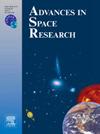南半球冬季电离层主槽位置与当地时间、经度和地磁活动的关系
IF 2.8
3区 地球科学
Q2 ASTRONOMY & ASTROPHYSICS
引用次数: 0
摘要
在早些时候根据 CHAMP 卫星数据对电离槽进行细致识别的基础上,又解决了两个问题:(1)纠正了电离层主槽位置的纵向效应特征,(2)首次确定了全时电离层主槽位置对地磁活动的依赖性。利用了太阳活动频繁时南半球冬季 CHAMP 卫星的大量数据集。根据改进后的数据,MIT 位置纵向效应的振幅在一天中从± 3° 变化到± 5°。纵向效应的形状随当地时间而变化,但东半球的 MIT 始终位于比西半球更高的纬度。产生纵向效应的主要原因是极光漫射降水的赤道边界取决于地球偶极子的倾角。对地磁活动的依赖是通过线性回归确定的 Λ = Λ - Kp,其中 Λ 是地磁纬度,Kp 指数考虑了前 6 h 的情况。纬度Λ和系数与当地时间有明显的相关性,从夜晚到白天,Λ会增加,而系数则会减少。由于纵向效应的振幅会随着磁活动的增加而减小,因此其值也取决于经度。因此,东半球和西半球的系数是分别确定的。平均值从白天的 1.3 - 1.4°到夜间的 1.8 - 1.9°不等。东西半球之间的差异为 0.3°。本文章由计算机程序翻译,如有差异,请以英文原文为准。
Dependence of the main ionospheric trough position on local time, longitude and geomagnetic activity in the southern winter hemisphere
Based on the meticulous identification of ionization troughs, performed earlier from the CHAMP satellite data, two additional issues were resolved: (1) the longitudinal effect characteristics in the position of the main ionospheric trough (MIT) were corrected, and (2) for the first time, the dependence of the MIT position on geomagnetic activity was determined for all local time hours. A large dataset from the CHAMP satellite in the southern winter hemisphere under high solar activity was utilized. According to the refined data the amplitude of the longitudinal effect in the MIT position changes from ∼ 3° to ∼ 5° in the course of the day. The shape of the longitudinal effect varies with local time, however, the MIT in the eastern hemisphere is consistently located at higher latitudes than in the western hemisphere. The main reason for the longitudinal effect is the dependence of the equatorward boundary of auroral diffuse precipitation on the tilt angle of the Earth’s dipole. The dependence on geomagnetic activity was determined as a linear regression ΛT = Λ0 − aKp, where Λ is the geomagnetic latitude, and the Kp index is considered for the previous 6 h. The latitude Λ0 and coefficient a exhibited pronounced dependence on local time, with Λ0 increasing and a decreasing when moving from night to day. Because the amplitude of the longitudinal effect decreases with increasing magnetic activity, the value of a also depends on longitude. Consequently, coefficient a was determined separately for the eastern and western hemispheres. The average values of a vary from 1.3 − 1.4° during the day to 1.8 − 1.9° at night. The difference between the eastern and western hemispheres is ∼ 0.3°.
求助全文
通过发布文献求助,成功后即可免费获取论文全文。
去求助
来源期刊

Advances in Space Research
地学天文-地球科学综合
CiteScore
5.20
自引率
11.50%
发文量
800
审稿时长
5.8 months
期刊介绍:
The COSPAR publication Advances in Space Research (ASR) is an open journal covering all areas of space research including: space studies of the Earth''s surface, meteorology, climate, the Earth-Moon system, planets and small bodies of the solar system, upper atmospheres, ionospheres and magnetospheres of the Earth and planets including reference atmospheres, space plasmas in the solar system, astrophysics from space, materials sciences in space, fundamental physics in space, space debris, space weather, Earth observations of space phenomena, etc.
NB: Please note that manuscripts related to life sciences as related to space are no more accepted for submission to Advances in Space Research. Such manuscripts should now be submitted to the new COSPAR Journal Life Sciences in Space Research (LSSR).
All submissions are reviewed by two scientists in the field. COSPAR is an interdisciplinary scientific organization concerned with the progress of space research on an international scale. Operating under the rules of ICSU, COSPAR ignores political considerations and considers all questions solely from the scientific viewpoint.
 求助内容:
求助内容: 应助结果提醒方式:
应助结果提醒方式:


